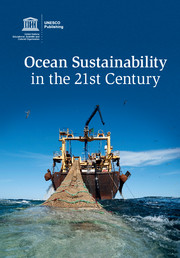Book contents
- Frontmatter
- Contents
- List of contributors
- Acronyms and abbreviations
- Foreword by Irina Bokova, Director-General of UNESCO
- Foreword by Thomas E. Lovejoy
- Preface
- Acknowledgements
- 1 Issues regarding oceans and opportunities: an introduction to the book
- 2 Main human uses of ocean areas and resources, impacts, and multiple scales of governance
- 3 Physical and chemical changes in the ocean over basin-wide zones and decadal or longer time-scales: perspectives on current and future conditions
- 4 Knowledge and implications of global change in the oceans for biology, ecology, and ecosystem services
- 5 A new perspective on changing Arctic marine ecosystems: panarchy adaptive cycles in pan-Arctic spatial and temporal scales
- 6 Ecosystem approach and ocean management
- 7 Challenges in using valuation in ecosystem-based management in a marine context: the case of UK Marine Protected Area designation
- 8 The contribution of international scientific cooperation and related institutions to effective governance for the oceans: the cases of regional tsunami early warning systems and the Argo project
- 9 Emerging and unresolved issues: the example of marine genetic resources of areas beyond national jurisdiction
- 10 The assumption that the United Nations Convention on the Law of the Sea is the legal framework for all activities taking place in the sea
- 11 The legal regime of outer space in light of the Law of the Sea
- 12 Towards sustainable oceans in the 21st century
- Index
- References
1 - Issues regarding oceans and opportunities: an introduction to the book
Published online by Cambridge University Press: 05 May 2015
- Frontmatter
- Contents
- List of contributors
- Acronyms and abbreviations
- Foreword by Irina Bokova, Director-General of UNESCO
- Foreword by Thomas E. Lovejoy
- Preface
- Acknowledgements
- 1 Issues regarding oceans and opportunities: an introduction to the book
- 2 Main human uses of ocean areas and resources, impacts, and multiple scales of governance
- 3 Physical and chemical changes in the ocean over basin-wide zones and decadal or longer time-scales: perspectives on current and future conditions
- 4 Knowledge and implications of global change in the oceans for biology, ecology, and ecosystem services
- 5 A new perspective on changing Arctic marine ecosystems: panarchy adaptive cycles in pan-Arctic spatial and temporal scales
- 6 Ecosystem approach and ocean management
- 7 Challenges in using valuation in ecosystem-based management in a marine context: the case of UK Marine Protected Area designation
- 8 The contribution of international scientific cooperation and related institutions to effective governance for the oceans: the cases of regional tsunami early warning systems and the Argo project
- 9 Emerging and unresolved issues: the example of marine genetic resources of areas beyond national jurisdiction
- 10 The assumption that the United Nations Convention on the Law of the Sea is the legal framework for all activities taking place in the sea
- 11 The legal regime of outer space in light of the Law of the Sea
- 12 Towards sustainable oceans in the 21st century
- Index
- References
Summary
1.1 Recognizing change in the oceans and its implications
Global change manifests itself in relation to multiple systems and sectors, including in the oceans. It is critical to understand the main features of these changes – which are in a large part human induced – as well as their effects on ocean life and processes, human well-being, and sustainable development in general, in order to frame possible responses to issues concerning the oceans today.
Providing an overview of change in the oceans is a challenging task. Perspectives on current and future ocean conditions ought to be based on documented change and variations in the physical, chemical, and biological nature of the marine environment over basin-wide zones and decadal or longer time-scales.
The active scientific community has been pursuing research on and observations of the marine environment since the genesis of modern oceanography, at the end of the 19th century. The second half of the 20th century has seen the development of international scientific research cooperative programmes such as the International Indian Ocean Expedition (IIOE) (1957 – onward). We now rely on an increasingly operational Global Ocean Observing System (GOOS), which encompasses ocean observing systems at multiple scales (national, subregional, and regional). Systems to detect ocean hazards, such as tsunami events, are being made operational on an ocean basin basis (cf. Chapter 8); daily ocean forecast services such as weather forecasting systems and services are becoming a reality.
Oceans are changing before our eyes; the magnitude and pace of those changes deserve special attention, further study, reflection and – it appears – urgent action.
One such change is ocean warming. Storage and transport of heat in the ocean are central drivers of the Earth's energy budget, which affects climate variability, the storm regime, moisture flux, and which can trigger expansion of the oceans, which is a major contributor to rising sea levels. Increasing temperatures also have an impact on nutrient supply to primary producers and influence species invasion.
- Type
- Chapter
- Information
- Ocean Sustainability in the 21st Century , pp. 1 - 20Publisher: Cambridge University PressPrint publication year: 2015



